NOTES
OVERVIEW
This is the final issue of this electronic product. It is intended that future state and territory-specific data will be made available in spreadsheet format with releases of the relevant annual national publications.
This electronic product provides a demographic overview of South Australia, 2004. It contains summary tables and commentary on trends in the components of population change including births, deaths and migration. Marriages, divorces, estimated resident population and various demographic rates are also presented. Population and migration data are for the year ended 30 June 2004, while births, deaths, marriages and divorces data are for the year ended 31 December 2004. More recent data are released quarterly in Australian Demographic Statistics (cat. no. 3101.0).
For comparisons between the states and territories of Australia, please refer to Demography, Australia, 2004 (cat. no. 3311.0.55.001). Demography publications for each state and territory can be accessed from the Related Information tab at the top of this page. Additional state demographic data are also available from publications and data cubes linked at the top of this page. The Demography Theme Page provides links to other Australian as well as international demographic statistics. The National Regional Profiles provide economic and social statistics of Statistical Local Areas and Local Government Areas of Australia.
INQUIRIES
For further information about these and related statistics, contact the National Information and Referral Service on 1300 135 070 or Max King on Adelaide (08) 8237 7599.
SUMMARY COMMENTARY
INTRODUCTION
South Australia accounted for 7.6% of the total Australian population at 30 June 2004. The state had the oldest population profile, lowest crude birth rate and lowest infant mortality rate of all states and territories in 2004.
POPULATION
The South Australian resident population was estimated to have reached 1,532,700 persons (759,200 males and 773,500 females) at 30 June 2004, accounting for 7.6% of the Australian total.
In 2003-04, the state's estimated resident population increased by 6,400 through a natural increase of 5,300 persons, a net overseas migration gain of 4,300 persons and a net interstate migration loss of 3,200 persons. At 0.4%, South Australia's annual population growth rate was lower than the national level of 1.1%.
POPULATION COMPONENTS, South Australia - 1994-2004
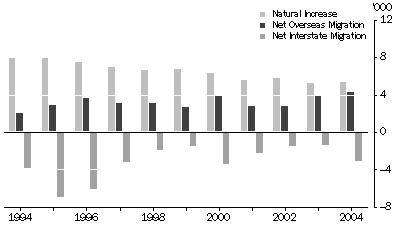
POPULATION AND HOUSEHOLDS, South Australia - Selected years at 30 June |
|  |
 |  |  | 1994 | 2003 | 2004 |  |
|  |
| Estimated resident population | ('000) | 1 466.1 | 1 526.3 | 1 532.7 |  |
| Components of population change(a) |  |  |  |  |  |
 | Natural increase(b) | no. | 8 006 | 5 198 | 5 318 |  |
 | Net overseas migration | no. | 1 994 | 3 904 | 4 305 |  |
 | Net interstate migration | no. | -3 978 | -1 497 | -3 197 |  |
| Total increase(a)(c) | no. | 5 464 | 7 605 | 6 426 |  |
| Annual growth rate(a) | % | 0.37 | 0.50 | 0.42 |  |
| Estimated resident households(d) | ('000) | 575.0 | nya | nya |  |
| Projected households(e) | ('000) | . . | 627.7 | 634.9 |  |
|  |
| . . not applicable |
| nya not yet available |
| (a) From 30 June of previous year. |
| (b) Excess of births over deaths. Births and deaths figures used to compile natural increase for population estimates are based on year of occurrence and may differ from births and deaths data based on year of registration displayed in the Births and Deaths sections of this paper. |
| (c) Includes intercensal discrepancy not accounted for by natural increase and net migration. |
| (d) Based on 1996 census data. |
| (e) Series II from Household and Family Projections, Australia, 2001-2026 (Cat. no. 3236.0). |
South Australia has a relatively older population profile than other states and territories. At 30 June 2004, 15.0% of the South Australian population was aged 65 years or more. This proportion was the highest of all states and territories (Tasmania was second at 14.1%). Similarly, a greater proportion of the South Australian population was aged 85 years or more (1.8% compared with the national average of 1.5%). Conversely, persons aged under 15 years comprised 18.6% of the South Australian population compared with 19.8% nationally. Females accounted for 56.2% of the South Australian population aged 65 years or more at 30 June 2004.
BIRTHS AND CONFINEMENTS
Over the year to 31 December 2004, there were 16,900 confinements resulting in 17,100 live births registered to mothers usually resident in South Australia. Of these births, 8,800 were registered as male and 8,300 as female, giving a sex ratio of 105.3 males per 100 females. Registrations of births declined by 1.7% over the previous year and were 11.7% lower than in 1994.
In 2004, South Australia had the lowest crude birth rate in Australia with 11.2 births per 1,000 population. The total fertility rate, that is the average number of babies that a woman might expect to bear during her reproductive lifetime, was 1.71 compared with the national level of 1.77. A female born in South Australia in 2004 might expect to have on average 0.82 daughters who survive to reproductive age, below the replacement level of 1.0.
The trend for people to have children later in life continued in 2004. For all confinements, the median age of South Australian mothers reached 30.8 years in 2004 and 33.0 years (where the age was known) for fathers. For first nuptial confinements (first child of a marriage), the median age of South Australian mothers in 2004 was 30.9 years, compared with 28.8 years in 1994.
CRUDE BIRTH RATES(a), Australia and South Australia - 1994-2004
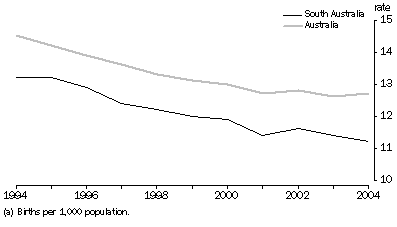
BIRTHS AND CONFINEMENTS, South Australia - Selected years(a) |
|  |
 |  |  | 1994 | 2003 | 2004 |  |
|  |
| Live births |  |  |  |  |  |
 | Number | no. | 19 409 | 17 443 | 17 140 |  |
 | Crude birth rate(b) | rate | 13.2 | 11.4 | 11.2 |  |
 | Total fertility rate(c) | rate | 1.741 | 1.722 | 1.707 |  |
 | Net reproduction rate(d) | rate | 0.838 | 0.822 | 0.823 |  |
| All confinements |  |  |  |  |  |
 | Number | no. | 19 134 | 17 142 | 16 869 |  |
 | Median age of mother | years | 29.2 | 30.6 | 30.8 |  |
| Nuptial confinements |  |  |  |  |  |
 | Number | no. | 14 041 | 11 144 | 10 848 |  |
 | Median age of mother | years | 30.1 | 31.7 | 32.0 |  |
 | Median age of father | years | 32.4 | 33.7 | 33.9 |  |
| First nuptial confinements |  |  |  |  |  |
 | Number | no. | 5 925 | 4 852 | 4 840 |  |
 | Median age of mother | years | 28.8 | 30.5 | 30.9 |  |
|  |
| (a) Year of registration. |
| (b) Births per 1,000 population. |
| (c) Births per woman. |
| (d) Daughters surviving to reproductive age per woman. |
In 2004, there were 653 Indigenous births (in which one or both parents identified as being of Aboriginal or Torres Strait Islander origin) registered to parents who were usually resident in South Australia. These births accounted for 3.8% of all South Australian births.
DEATHS
Over the year to 31 December 2004, there were 11,600 registered deaths of persons usually resident in South Australia (5,900 males and 5,700 females). The number of registered deaths was 0.7% lower than the number registered in 1994. When population size is taken into account, figures show little movement over the last 10 years. The crude death rate was 7.6 deaths per 1,000 population in 2004, down marginally from 8.0 in 1994.
There are significant differences between male and female mortality statistics for South Australia. Crude death rates for males have been consistently higher than those of females. In 2004, there were 7.8 male deaths per 1,000 males in the population compared with 7.4 female deaths per 1,000 females in the population.
Based on the median age at death, males also have a shorter life expectancy than females. In 2004, the national median age at death was 76.6 years for males compared with 82.6 years for females. In 2004 South Australia had the highest median age at death in Australia for both males (77.5 years) and females (83.2 years). The life expectancy for males born in South Australia in 2004 is 78.0 years, over five years less than that of females (83.1 years). These closely compare with the national life expectancy figures for both genders.
CRUDE DEATH RATES(a), South Australia - 1994-2004
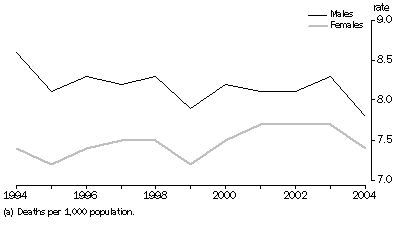
In 2004, South Australia recorded the lowest infant mortality rate of all states and territories, with 3.2 infant deaths per 1,000 live births compared with 4.7 nationally. Infant mortality rates have improved significantly over the last 20 years, with the South Australian level falling from 7.6 in 1984.
DEATHS, South Australia - Selected years(a) |
|  |
 |  |  | 1994 | 2003 | 2004 |  |
|  |
| Number | no. | 11 710 | 12 185 | 11 629 |  |
| Crude death rate(b) | rate | 8.0 | 8.0 | 7.6 |  |
| Standardised death rate(c) | rate | 8.1 | 6.6 | 6.2 |  |
| Median age at death |  |  |  |  |  |
 | Males | years | 74.3 | 77.5 | 77.5 |  |
 | Females | years | 80.9 | 83.1 | 83.2 |  |
| Infant deaths |  |  |  |  |  |
 | Number | no. | 92 | 65 | 54 |  |
 | Infant mortality rate(d) | rate | 4.7 | 3.7 | 3.2 |  |
| Life expectancy at birth(e) |  |  |  |  |  |
 | Males | years | 75.1 | 77.7 | 78.0 |  |
 | Females | years | 81.2 | 82.7 | 83.1 |  |
|  |
| (a) Year of registration. |
| (b) Deaths per 1,000 population. |
| (c) Deaths per 1,000 population. Standardised death rates use total persons in the 2001 Australian population as the standard population. |
| (d) Deaths per 1,000 live births. |
| (e) From 1995 onwards expectation of life has been calculated using three years of data. |
MIGRATION
Over the 12 months to 30 June 2004, South Australia gained 4,300 people through net overseas migration. Overseas arrivals included 18,000 persons who intended to stay in South Australia for one year or more and departures included 10,400 persons who intended to stay abroad for at least 12 months.
South Australia recorded another net interstate loss (3,200 persons) in 2003-04. There were 30,200 persons who changed their usual residence from South Australia to another state or territory while 27,000 persons arrived from interstate. Net losses were to Queensland (2,000 persons), Victoria (750), Western Australia (600), Tasmania (200) and the Australian Capital Territory (130) while net gains were from the Northern Territory (430) and New South Wales (20). Of South Australia's net population loss due to interstate migration, 47.0% were aged between 20 and 34 years.
NET INTERSTATE MIGRATION, South Australia - at 30 June 2004
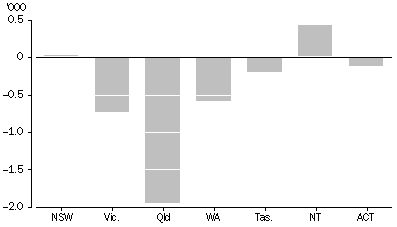
MARRIAGES
There were 7,900 marriages registered in South Australia in 2004, up 3.6% on 2003 but down by 11.5% from the number of marriages registered in 1994. The median ages of brides and bridegrooms continued to rise (to 29.3 and 31.8 years respectively in 2004), reflecting the long-term national trend towards marrying at older ages.
In South Australia in 2004, most couples (74.8%) cohabited prior to their marriages. Most marriages (65.1%) were between people neither of whom had been previously married and just over half of marriages (55.2%) were performed by civil celebrants.
MARRIAGES, South Australia - Selected years(a) |
|  |
 |  |  | 1994 | 2003 | 2004 |  |
|  |
| Number registered(a) | no. | 8 909 | 7 609 | 7 883 |  |
| Crude marriage rate(b) | rate | 6.1 | 5.0 | 5.1 |  |
| Median age at marriage |  |  |  |  |  |
 | Bridegroom | years | 29.0 | 31.2 | 31.8 |  |
 | Bride | years | 26.7 | 29.2 | 29.3 |  |
|  |
| (a) For 2004, marriage registrations were sampled for South Australia and therefore subject to sampling error. |
| (b) Marriages per 1,000 population. |
DIVORCES
In 2004, there were 4,100 divorces granted in South Australia and the crude divorce rate was 2.7 divorces per 1,000 population.
DIVORCES, South Australia - Selected years |
|  |
 |  |  | 1994 | 2003 | 2004 |  |
|  |
| Number granted | no. | 4 192 | 4 151 | 4 147 |  |
| Crude divorce rate(a) | rate | 2.9 | 2.7 | 2.7 |  |
| Median duration of marriage |  |  |  |  |  |
 | To separation | years | 8.2 | 9.3 | 10.0 |  |
 | To divorce | years | 11.2 | 12.8 | 13.6 |  |
|  |
| (a) Divorces per 1,000 population. |
REGIONAL SUMMARY
The resident population of the Adelaide Statistical Division (SD) was estimated to have reached 1,123,200 persons at 30 June 2004, accounting for 73.3% of the South Australian population. The Adelaide SD is comprised of four Statistical Subdivisions (SSDs) - Northern, Southern, Eastern and Western - which contain Local Government Areas (LGAs). At 30 June 2004, Northern Adelaide was the most populated SSD with 358,000 persons or 31.9% of the Adelaide SD's population. The most populated Local Government Area (LGA), with 153,300 persons, was the City of Onkaparinga in the Southern Adelaide SSD.
At 30 June 2004, Outer Adelaide (121,300 persons), Northern (77,600) and Murray Lands (68,500) were estimated to be the most populated SDs outside the Adelaide SD. Lower South East (44,000 persons), Riverland (41,700) and Mt Lofty Ranges (41,200) were the most populated non-metropolitan SSDs while Mount Barker (DC) was the most populated non-metropolitan LGA with 25,600 persons.
The Adelaide SD recorded 71.9% of the state's births and 73.0% of the state's deaths, reflecting the region's share of the population. However, Adelaide SD's three-year average fertility rate (1.6) and its three-year average indirect standardised death rate (6.4) were both lower than those recorded in non-metropolitan South Australia (2.1 and 6.8 respectively). Within the Adelaide SD, the Northern SSD had the highest three-year average fertility rate of 1.8.
LARGEST NON-METROPOLITAN POPULATIONS, South Australia - by LGA(a) - at 30 June 2004
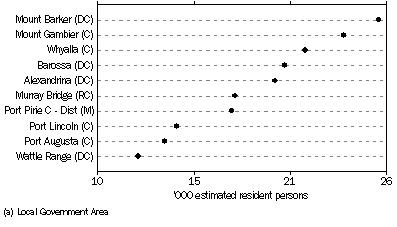
RELATED LINKS
Demographic data for all South Australian statistical local areas are available from the data cube linked on the Details tab at the top of this page.
From the Related Information Tab there are links to other releases providing more specific or in-depth analysis and information
 Print Page
Print Page
 Print All
Print All